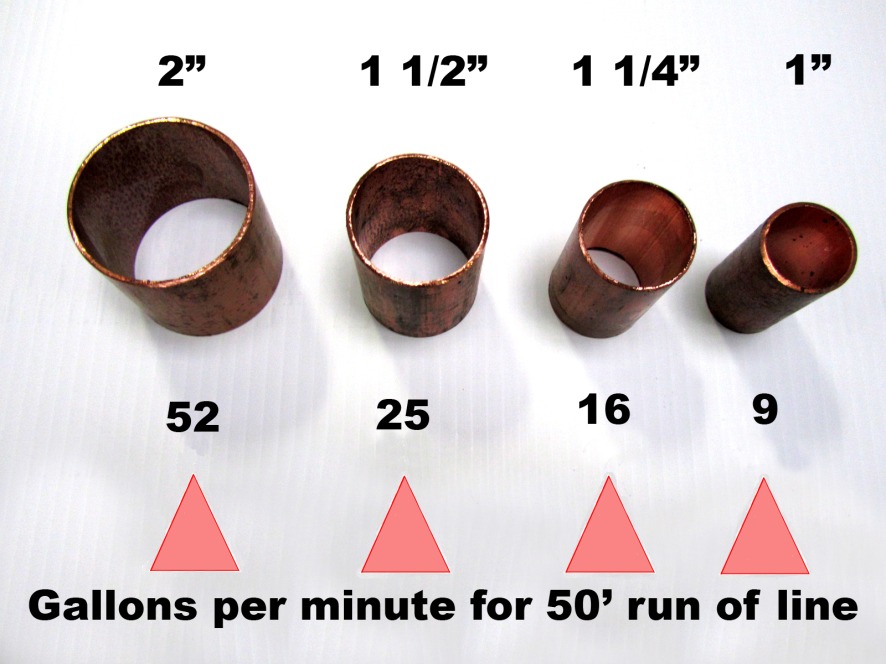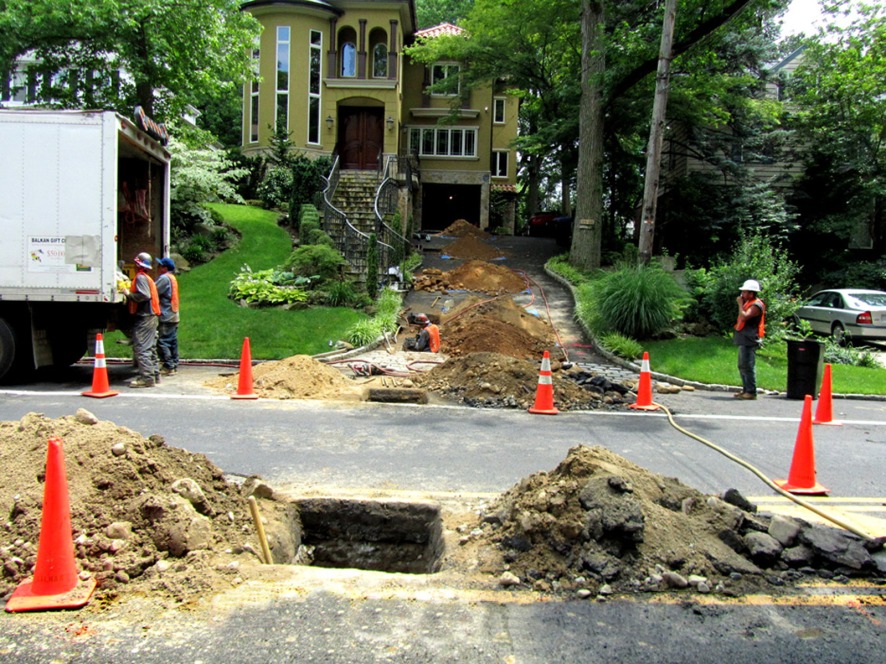3 Woter Supply With 34 Feed
The water line size is vital to providing adequate volume of water to the occupants of a building. There are three main factors that determine the correct water supply line size, which is also referred to as the water service line. The three factors are as follows:
- Plumbing fixture count: A calculation using all of the plumbing fixtures in a building.
- The length of the run of pipe: The distance from the main inside control valve to the connection on the city water main.
- Classification of the building: Residential and Commercial buildings have different sizing requirements.
Some water supply line size facts simplified
Increasing the water supply line size to just one pipe size larger makes a dramatic difference. What individuals that are not in the plumbing trade do not realize, is that understanding length and understanding area are quite different factors from each other.
As an example 1 1/4″ is only 25% larger than 1″. But in terms of area, the inside area of these size pipes (water supply tubing) is a difference of about 56% greater. As another example let's compare 1 1/2″ pipe to 2″ pipe. The difference in area inside an 1 1/2″ pipe compared to a 2″ pipe is around 77%.

Different size lines provide dramatically different flow rates
In terms of the DEP water supply line size table, whose key component is gallons per minute, the differences are even more dramatic. Basing calculations of an average run of pipe of 50′, an 1 1/4″ line provides 16 gallons per minute. On the other hand a 1″ line only provides 9 gallons per minute. Therefore an 1 1/4″ line provides almost 77% more gallons per minute than a 1″ line.The gallon per minute calculations on the DEP sizing table are also based upon some other vital assumptions. All flow calculations are based upon connecting to the proper size of tap connection on the city water main. They are also based upon the building being on level ground. As an example, a house located on a hill or raised ground will decrease the flow rate.
What does all this mean to the average property owner? It means that for a nominal amount of money, increasing the size by just one size of water supply line provides dramatic benefits. The photo below clearly illustrates this point. But it should also be noted that if the inside plumbing on a building is undersized, no benefit will be derived by increasing the service line size unless the inside plumbing is also increased as well.

What water supply line size is typically required?
A typical one family house is supplied by a 1″ water service line. A one family house typically has the following plumbing fixtures present:
- Kitchen sink
- Laundry tray
- Dishwasher
- Washing machine
- Full bathroom
- An outside hose connection.
A two family house can virtually never size out for a 1″ service line. The only exception would be the extremely odd case of a city water main being located under the public sidewalk. The house would have to have no front yard whatsoever; which would result in only a 15′ run of pipe. Obviously this is a very uncommon and rare situation.
In the case of a three family house an 1 1/2″ service line is typically required. Again the exception would be if the length of the run of pipe was only 35′ or less. In most cases a six family house or greater will require a 2″ water service line.Every type of plumbing fixture has an estimated gallons per minute factor. All of the plumbing fixtures inside a building combine to factor into the required water service line size for the building.
Cases vary in determining the proper water supply line size
The actual reality that exists is that most older buildings, those built prior to 1990 or so, will frequently have lines smaller than suggested above. In many cases this results in no ill-effects, as the NYC DEP sizing table is very conservative. However each case will vary. As an example, in some neighborhoods there are six family homes served by lead water service lines smaller than 1″. In extreme cases like this the water pressure drops, and inadequate volume are normal everyday issues for the occupants. Remember, even if you've gotten used to it, a pressure drop when using water in your home is not normal. No home or property was designed for this to happen.
Let an expert size your water service line
Sizing tables differ for residential and commercial properties
The sizing table differs dramatically for a commercial property as compared to a residential property. There is good reason for that. Among the chief reason is that a plumbing fixture typically gets used much more frequently in a commercial space. As an example a sink in a one family house is used sparingly as compared to a sink inside a busy restaurant.
Fixture count is the gallons per minute value each plumbing fixture is attributed in the sizing table. As an example the DEP sizing table sinks, dishwashers, and washing machines are attributed a fixture count of 4. While like residential plumbing fixtures have exactly 1/2 that fixture count. As a result the DEP sizing table, commercial properties typically require much larger water service lines than residential properties to meet code.
Why the length of the run is a factor
Part of supplying water to a building is based upon pressurized water passing through the water supply line. The line itself provides resistance to the water flow. Therefore the length of the run is a major factor. The longer the run, the less gallons per minute can flow through the service line.

A long run of pipe affects the size of the line required
Length of run actually has a dramatic affect on the supply capabilities of each water service line size. As an example the typical water service line will lose approximately 33% of its water delivery capability when the length of the run is increased from 30′ to 60′. As a specific example an 1 1/4″ line can deliver approximately 21 gallons per minute over a 30′ run, yet only approximately 14 gallons per minute over a 60′ run.
While the length of run is a major factor for all water supply line size calculations, it becomes more of factor when the run is unusually long. When a building has a large set-back from the property, or is on w very wide roadway, it is easy to overlook the this factor. In cases where there is a long run it would be an error to base the water supply line size strictly on the fixture count.
Typical signs of inadequate water volume or water pressure
Occupants of a building may have longstanding issues with insufficient water volume or pressure, and accept it as normal. It should be understood that water pressure and water volume are two separate and distinct issues. Water pressure is the force that water flows from a plumbing fixture. Water volume is the amount of water present to service an entire building.
Three typical issues that result from volume or pressure problems are as follows:
- Water temperature changes when water is used in the building, such as a toilet being flushed.
- Loss of water pressure when a shower or washing machine is being used.
- Change in water pressure or volume when a lawn sprinkler system kicks on.
Water pressure and volume issues and solutions can be complicated. Frequently they do not involve the water supply line size, but other issues are the cause. It is always best to trust a Licensed Master Plumber to investigate and resolve plumbing issues like these. Only a skilled and licensed plumber will have the knowledge and expertise to provide a correct and cost effective solution.
Master Plumber Paul R. Balkan explains sizing water lines
Paul R. Balkan is the President of Joseph L. Balkan Inc. He is an expert in the field of house sewer and water service line work. Here are some of his insights concerning water pressure and sizing issues.

Paul R. Balkan, President Joseph L. Balkan Inc.
There are several factors involved in getting adequate water flow out of the plumbing fixtures in a building. Water pressure is usually measured as pounds per square inch. When no water is being used in a building, and assuming there is no pumps or roof tanks, or other devices being used, the maximum height that water can rise in a building is determined by the pressure in the City Water Main.
One psi (pound per square inch) will raise water vertically 2.31 feet. If the pressure in the City water main is 40 psi the water will raise a maximum of 92.4 feet vertically above the City water main. It is important to realize that this is not affected by the size of the pipes.
The size of the pipes becomes important when water is being used in the building. The larger the diameter of the supply pipes the less of a pressure drop will occur as more and more plumbing fixture are used at the same time. One way of looking at it is to imagine the size of the supply pipe as being like a valve. If you were to connect a garden hose to a fire hydrant and barely open the hydrant valve, the equivalent to having a small supply pipe, the water coming out of the hose might go 30'.
On the other hand, without adjusting the valve, disconnect the garden hose and connect a fire hose instead. This is similar to having a lot of plumbing fixtures attached to an undersized water supply. The water might then only go 1-2'. Opening the valve all the way, equivalent to a large supply pipe, and the pressure of the water coming out of the hose could knock somebody over. Nothing changed in the City water main supplying the hydrant, just the size of the passageway that the water had to go through. Naturally this is a thought exercise, and fire hydrants should not be tampered with!
Get a free on-site visit today!
Source: https://www.balkanplumbing.com/required-main-water-supply-line-size/
0 Response to "3 Woter Supply With 34 Feed"
Post a Comment